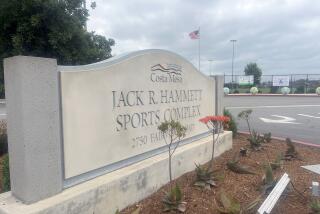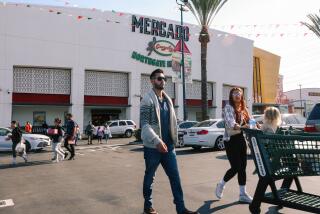FOCUS : Mesa North: A Neighborhood of Basketball Hoops and RVs in the Driveway
- Share via
Bet you don’t know where the Mesa North neighborhood is in Costa Mesa. Even the city planning office wagered incorrectly that it was somewhere north of the San Diego Freeway.
“People think anything called ‘north’ must be north of the freeway. But the freeway hasn’t always been there, you know,” said Betty Beecher of the Costa Mesa Historical Society. She has lived in Costa Mesa since 1936 and remembers many forgotten boundaries and guideposts.
Mesa North is located south of the interchange of the San Diego and Corona del Mar freeways, bordered on the west by Fairview Road and on the south by a drainage ditch slightly past but directly parallel to Baker Street.
“That drainage ditch was one of the outside borders of the Santa Ana Army Air Base. One time we had a fellow who was stationed there during the war come back for a visit. We drove him around, and when he saw that ditch, he remembered that his old barracks were located somewhere next to it,” Beecher recalled.
“I couldn’t have told you exactly where Mesa North is either. That area is part of what was called Paularino, so I just call it that.”
The Paularino area was formed after the partitioning of Rancho Santiago de Santa Ana, the early Spanish land grant, in 1868. Its boundaries extended roughly from Fairview Road, between Adams and Gisler avenues, over to Newport Boulevard. Mesa North, in effect, is the west end of the old Paularino farming community. It is named after one of its early owners, Eduardo Pollereno. The area is also referred to as the Boston Colony because it was first settled by several farm families from Boston, Mass. Baker Street was named for the M.A. Baker family, which arrived in 1900.
A business center was never established in early Paularino, and farmers had to travel once a week to nearby Fairview (hence Fairview Road) or to Santa Ana to shop and conduct business.
Such is not the case for contemporary residents. The one-mile section of Baker Street that borders Mesa North offers businesses that cater to shoppers’ eclectic hobbies and whims of variety and convenience.
There is a drive-in cleaners.
One must choose between Taco Bell and Del Taco. There are two Mexican, one Chinese and four Italian restaurants, if you count the pizza parlors.
There are two florists, one that sells 99-cent roses and lottery tickets, located near a video store that rents movies for 94 cents and has talking gum-ball machines. Next door is a new and used record store where you can get the Rolling Stones’ “Get Your Yah Yahs Out” LP for $1.99 or “Tommy Dorsey and His Orchestra featuring Frank Sinatra” for 50 cents.
One of the five beauty salons advertises that it is open every day and has bilingual hairdressers.
In addition to a supermarket and super drugstore, there are small shops devoted individually to fishing, stamp collecting and model trains.
Just behind the storefronts on Baker Street is a strip of small factories, warehouses and workshops. The German Home Bakery is here, next to woodworkers, printers and sign-makers.
Somehow all of this commercial activity does not disrupt the quiet of Mesa North’s residential area. Somerset Townhomes, the area’s most recent residential development, was completed along Baker in 1981. But the neighborhood consists mainly of single-story homes built in the late 1950s and early 1960s.
Farmland until then, Mesa North was one of the last residential developments in the city of Costa Mesa and takes its name from one of its first housing tracts. It is a casual neighborhood with basketball hoops on the garages and RVs parked out front.
There are no obvious reminders of the early settlers, though, not even a building or a tall old tree. Paularino’s one-room schoolhouse, built just outside Mesa North in 1909, was demolished last year, erasing the last structural landmark of the original Paularino area.
Population Total: (1989 est.) 3,845 1980-89 change: +4.7% Median Age: 32.7 Racial/ethnic mix: White (non-Latino), 76%; Latino, 11%; Black, less than 1%; Other, 13%
By sex and age: MALES Median age: 31.8 years FEMALES Median age: 33.9 years
Income Per capita: $14,310 Median household: $46,630 Average household: $49,119
Income Distribution: Less than $25,000: 20% $25,000-49,999: 36% $50,000-74,999: 29% More than $75,000: 15%
More to Read
Sign up for Essential California
The most important California stories and recommendations in your inbox every morning.
You may occasionally receive promotional content from the Los Angeles Times.










